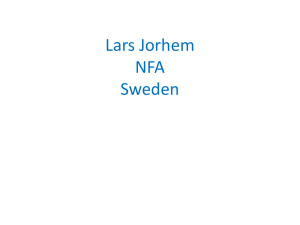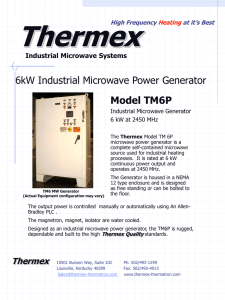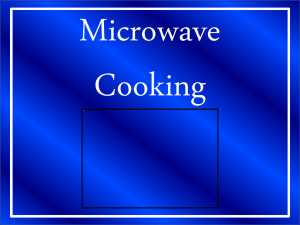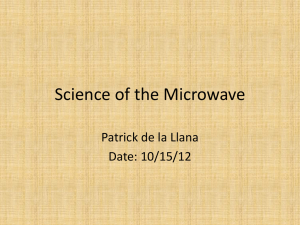RF 기초이론
advertisement
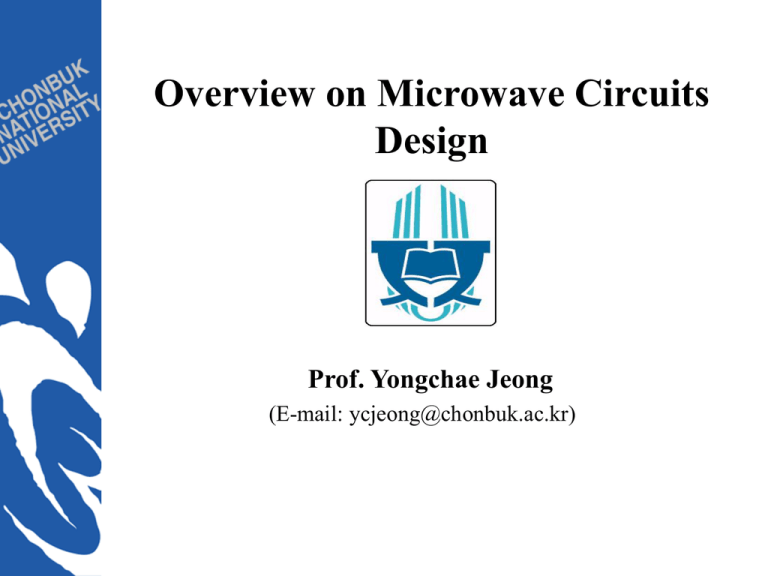
Overview on Microwave Circuits Design Prof. Yongchae Jeong (E-mail: ycjeong@chonbuk.ac.kr) Overview on Microwave Circuits Design 1. Electronics 2. Radio Wave 3. Comparison between Analog, Digital and Microwave, 4. Microwave Applications 5. Measurement Systems for Microwave Circuits 6. Curriculum for Microwave Engineering 7. Basic Concepts in Microwave Circuit Design 8. RF Transceiver Architectures 1. Electronics -어원 : Electronics= Electron (전자)+ics (학문명 접미사) -정의 1 : 진공 속이나 기체, 고체 내에서의 전자의 운동을 연구하는 학문 및 그 것을 이용하는 기술 -정의 2 : 전자기술의 다방면에 걸친 발전과 그 두드러진 유용성으로 인해 생긴 개념으로 초기에는 진공 또는 기체 속에서 이루어지는 전자 운동의 이 용을 초점으로 하는 것이었으나, 1948년 미국 벨 연구소에서 개발한 트랜지스터에 의해서 질적으로 변화하여 반도체내의 전자의 운동을 이용하는 이론과 기술이 전자공학의 주류로 변화 -기술적 특징 : 빛, 열, 음, 전자파 등을 전기 신호화해서 전송하고 처리 -고체 전자공학(반도체)의 발전 과정 Diode(진공관 다이오드, 반도체 다이오드) Transistor(트랜지스터) IC(Integrated Circuit: 집적회로) VLSI(Very Large Scale Intefration:초대규모 집적회로) Digital IC Analog IC, RFIC(Radio Frequency IC), MMIC(Monolithic Microwave IC) OEIC (Optoelectronic IC) 1. Electronics 그림 1. 전자 공학의 흐름도 2. Radio Wave -Radio Wave -인공적인 매개물이 없이 공간에 전파하는 3THz 보다 낮은 주파수의 전자파 -무선통신에 사용되는 무선 주파수를 포함하여 적외선, 가시광선, 자외선, X선, 우주선 등을 총칭 -전파의 사용 범위는 대체로 3kHz ~ 3THz 의 주파수를 갖는 전자파 -무선통신, 라디오 방송, TV 방송, 무선 항해, 레이더 등은 모두 전파를 이용하 는 것으로, 전파가 점유하는 주파수 범위는 매우 넓고 주파수에 따라 파장이 나 전파되는 특성이 다르며, 현재 국제 전기 통신 협약과 전파법에 의해 관리, 이용되고 있는 것은 일부분에 불과 그림 2. 전자파의 예 2. Radio Wave 전파의 성질 1)전파의 직진 : 동일 매개체를 통과할 경우에 직진하는데 주파수가 높을수록 직진성이 강함 2) 전파의 반사 및 굴절 : 빛이 물속을 통과할 때처럼 전파 또한 다른 물질로 구성된 매개체를 통과할 경 우에는 그 물질의 경계면에서 일부는 반사되고 일부는 진행방향이 변하여 투과 되면서 굴절 3) 전파의 회절 :전자파는 빛과 마찬가지로 전파 경로상에 산악 또는 건물 등과 같은 장애물이 있는 경우, 그 뒤쪽에서 전파의 일부가 휘어져 수신 4) 전파의 간섭 ① 시간차에 의한 간섭 : 동일 기지국에서 방사된 동일한 주파수가 여러 경로를 거치면서 전파 의 도달 시간에 차이가 생겨 발생 ②인접 채널 간섭 : 서로 다른 기지국으로부터 발사되는 동일한 주파수로 인해 일어나는 간섭 ③동일 채널 간섭 : 여러 단말기가 동시에 통화시도를 하면 같은 채널을 사용하게 되는데, 이때 반대쪽에서 나는 간섭 2. Radio Wave 그림 3. 전파의 전파 경로 2. Radio Wave RF의 정의 -RF (Radio Frequency) : 방사 ( 방파 ) 주파수 • 전자파를 이용한 무선장비의 소자 및 시스템 RF : 1GHz • 사전적 의미 Microwave : 300MHz ~ 300GHz - 대략 100 ~300MHz 이상의 고주파 무선통신 및 고주파를 이용하는 소자, 부품, 시스템, 관련 장비 분야. 2. Radio Wave 주파수(Frequency)의 정의 • 전자파가 움직이는 보이지 않는 길(지정된 주파수를 통하여 정 보를 교환) ⇒ 파장 또 진동수를 기준으로 한 약속 • 1초 동안에 일정한 주기로 진동하는 횟수 [Hz] • f c Hz (c 3 10 8 m/s) 그림 4. 주파수의 개념 2. Radio Wave *상업적인 RF 대역 표 1. 무선 주파수 대역 2. Radio Wave *Microwave 대역 표 2. Microwave 대역 3. Comparison between Analog, Microwave, Digital 그림 5. Analog 와 Digital 4. Microwave Applications 무선 및 이동 통신에서의 RF [Super Heterodyne 방식] 그림 6. Super heterodyne 형태의 AM 수신기의 기본적인 요소 Super Heterodyne 방식 : 수신기의 감도를 높이기 위해서 고주파 증폭기의 이득을 크게 한다 는 것에 한도가 있으므로, 고주파 신호를 한번 주파수가 낮은 증간 주파수로 변환시켜 이것을 증폭한 후에 복조하여 저주파 증폭을 하는 방식으로 회로가 복잡하고 가격이 비싸지만, 감도와 선택도가 향상되고 광대역에 걸쳐 주파수 충실도가 우월 Direct Conversion (Zero IF) 방식 : IF를 사용하지 않으므로 채널의 선택도와 감도가 떨어지 긴 하지만, IF단을 사용하지 않기 때문에 가격면에서 저가이고 공간을 절약할 수 있으므로 작고 가벼움. IF (Intermediate Frequency) : 주파수변환기에 의해 수신 전파의 주파수와 국부 발진기 주파 수 차에 해당하는 주파수(수신측), 일반적으로 중간 주파수는 수신 주파수보다 낮게 하여 증폭하기 쉽고 선택도 및 충실도를 높게 하는 것 4. Microwave Applications 4. Microwave Applications 일반적인 시스템 구조 4. Microwave Applications Direct Conversion 방식 4. Microwave Applications Super Heterodyne 방식 4. Microwave Applications 4. Microwave Applications RF 와 Microwave를 사용하는 이유 • 고주파에서 더 넓은 대역으로 전달 (정보 운반 능력) • 작아지는 시스템에 따르는 소자의 크기 문제 • 동작에 있어 높은 속도를 요구 • 안테나 이득은 안테나의 전기적인 크기에 비례 • 작은 파장에 따른 안테나의 길이 문제 해결 • 신호가 전리층에서 튀지 않으므로 지상과 위성과의 통신이 가능 4. Microwave Applications *RF 응용분야 표 3. RF 응용분야 4. Microwave Applications 4. Microwave Applications 4. Microwave Applications 4. Microwave Applications 4. Microwave Applications 4. Microwave Applications 4. Microwave Applications 4. Microwave Applications 4. Microwave Applications 5. Measurement Systems for Microwave Engineering Network Analyzer: 하 나 의 기 계 안 에 주 파 수 Source 와 Spectrum Analyzer가 들어있어서, 입력 과 출력의 주파수 신호분포결과를 서로 나눔으로써 S 파라미터를 측정하는 장비 그림7. 8510C Network Analyzer Systems, 45 MHz to 110 GHz 5. Measurement Systems for Microwave Engineering Scalar Network Analyzer : magnitude Vector Network Analyzer : magnitude, phase time domain frequency domain Linear Device만 측정 가능(Frequency Doubler, Mixer등은 측정 불가능) Delay Reflection 측정 Transmission 측정 (1 port device) SWR S-parameter(S11, S22) Reflection Coefficient Impedance Return Loss (2 port device) Gain or Insertion Loss S-parameter(S11, S22) Transmission Coefficient Insertion Phase Group Delay 5. Measurement Systems for Microwave Engineering Spectrum Analyzer: 1-port 측정 장비로 계측기 입력단에서 어느 주파수 성분이 감지되는지를 표시하는 장비, Phase Noise도 측정. 그림8. 8563EC Portable Spectrum Analyzer, 9 kHz to 25.6 GHz 5. Measurement Systems for Microwave Engineering Noise Figure Meter (or Analyzer): 잡음을 임의로 발생시키는 Noise Source와 잡음지수를 측정하는 Noise Figure meter 로 구성, 회로와 수신부 시스템의 잡음지수를 측정, Tuner를 사용하여 Noise Figure Parameter를 추출 가능, 저잡음 증폭기의 잡음지수 연구와 수신부의 잡음지수 측정에 필수적인 장비 그림9. N8975A Series Noise Figure Analyzer 5. Measurement Systems for Microwave Engineering Power Meter: Power 측정 그림10. E4418B Single-Channel Power Meter 5. Measurement Systems for Microwave Engineering Probe Station: Wafer 및 Chip sample등 전자 소자들의 전자, 전기적 특성 및 물성 연구에 주로 사용 하는 소자 탐침용 장비. 주로 I-V, C-V, 각종 파라미터 및 Wafer의 신뢰성을 테스트 그림11. Cascade Microtech Probe System 6. Curriculum for Microwave Engineering 전자기학(Electromagnetics): Vector 및scalar, 정전계, 유전체의 정전용량, 자성체와 인덕턴스, 정자계의 특성 을 익히고 시변계에서 Maxwell 방정식을 통해 기본적인 전자기적 현상을 이해 회로이론(Circuit Theory): 키르히호프법칙, RLC 응답, Laplace 변환, Fourier변환 등의 여러회로 이론들에 대한 이해 물리전자(Solid State Electronic Device): 반도체 소자의 특성과 동작의 원리, 다이오드와 트랜지스터의 이해 전자회로(Electronic Circuit): 다이오드, 바이폴라 트랜지스터, FET와 같은 전자소자의 동작원리를 습득하며, 이 들의 소신호 모델을 이용한 증폭회로의 해석과 설계 기법을 학습 초고주파공학(Microwave Engineering): 전송선이론, 초고주파 회로망분석, 정합이론 및 각종 초고주파 소자 및 증폭기에 대한 이해 무선통신회로 및 실험(Wireless Communication Circuits and Experiments): 무선통신시스템의 구성하고 있는 주요 회로의 동작 및 설계 방법을 학습 전파공학(Wave Propagation Engineering): 대기 중에서의 전파의 전파 과정과 안테나의 설계이론 학습 7. Basic Concepts in Microwave Circuit Design Memoryless system A system is called “memoryless” if its output does not depend on the past values of its input. For memoryless linear system, y(t)=x(t) where is a function of time if the system is time variant For a memoryless nonlinear system, the input-output relationship can be approximated with a polynomial, yt 0 1 xt 2 x 2 t 3 x3 t where j are in general functions of time if the system is time invariant For memoryless and time-variant systems, yt 1xt 2 x2 t 3 x3 t Microwave Circuits Design Lab. 37 7. Basic Concepts in Microwave Circuit Design Harmonics If a sinusoid is applied to a nonlinear system, the output generally exhibits frequency components that are integer multiples of the input frequency. if x(t)=Acost, then y t 1 A cost 2 A2 cos2 t 3 A3 cos3 t 2 A2 3 A3 1 cos 2t 3 cost cos3t 2 4 3 3 A3 3 A3 2 A2 2 A2 cost 1 A cos 2t cos3t 2 4 2 4 1 A cost where the input frequency (): “fundamental” the higher-order terms(n, n:integer): “harmonics.” Even-order harmonics result from j with even j and vanish if the system has odd symmetry, i.e., if it is fully differential. th n The amplitude of the n harmonic consists of a term proportional to A and other terms proportional to higher powers of A. Microwave Circuits Design Lab. 38 7. Basic Concepts in Microwave Circuit Design Gain Compression The small signal gain (1)of circuit is usually obtained with the assumption that harmonics are negligible. 3 3 A3 3 A3 2 A2 y t 1 A cos 2t cos3t cost 2 4 2 4 1 A cost @ A is small 2 A2 3 3 A3 1 A cost @ A is not small 4 In most circuits of interest, the output is a “compressive” or “saturating” function of input. At high input level, gain is a decreasing function of A. 1 33 A2 / 4 0 Microwave Circuits Design Lab. 1 3 , 1 0, 3 0 39 7. Basic Concepts in Microwave Circuit Design 1-dB compression point(P1dB): The input signal level that causes the small signal gain to drop by 1dB. Fig. 7 Definition of 1dB compression point To calculate the 1-dB compression point, 4 A1dB 0.1087 1 0.145 1 3 3 3 Microwave Circuits Design Lab. 40 7. Basic Concepts in Microwave Circuit Design Desensitization and blocking When the desired signal is fed to circuit with a strong interferer, the “average” gain of the circuit is reduced because of a large interferer : “desensitization” xt A1 cos1t A2 cos2t A1 cos1t : signal, A2 cos2t : interferer 3 x 3 (t ) 3 A1 cos1t A2 cos2t 3 3 A13 cos3 1t 3 A12 A2 cos2 1t cos2t 3 A1 A22 cos1t cos2 2t A23 cos3 2t 1 cos 22t A13 3 3 cos1t cos31t 3 A12 A2 cos2 1t cos2t 3 A1 A22 cos1t 2 4 A23 cos3 2t 3 3 3 A13 cos1t A1 A22 cos1t 4 2 3 3 yt 1 A1 3 A13 3 A1 A22 cos1t 4 2 Microwave Circuits Design Lab. 41 7. Basic Concepts in Microwave Circuit Design For A1 << A2, 3 yt 1 3 A22 A1 cos1t 2 For 3<0 and sufficiently large A2, the overall gain drops zero, and we say the signal is “blocked” in RF design. Many RF receivers must be able to withstand blocking signals 60 to 70dB greater than the wanted signal. Filter, Matching circuits, etc. Microwave Circuits Design Lab. 42 7. Basic Concepts in Microwave Circuit Design Cross Modulation When a weak signal and a strong interferer pass through a nonlinear system, the transfer of modulation on the amplitude of the the interferer to the amplitude of the weak signal is occurred. A2 cos2t A2 (1 m cosmt ) cos2t (m 1, modulationindex) yt 1 A1 cos1t 3 3 A1 cos1t A2 1 m cosmt cos2t 2 3 m2 m2 2 1 A1 3 A1 A2 1 cos 2mt 2m cosmt cos1t 2 2 2 The desired signal at the output contains amplitude modulation at m and 2m. Microwave Circuits Design Lab. 43 7. Basic Concepts in Microwave Circuit Design Intermodulaton When two signals with different frequencies are applied to a nonlinear system, the output in general exhibits some components that are not harmonics of the input frequencies. Intermodulation distortion(IMD) xt A1 cos1t A2 cos2t yt 1 A1 cos1t A2 cos2t 2 A1 cos1t A2 cos2t 3 A1 cos1t A2 cos2t Fundamental components 2 3 3 3 1 , 2 : 1 A1 3 A13 3 A1 A22 cos1t 4 2 3 3 1 A2 3 A23 3 A2 A12 cos2t 4 2 Intermodulation products: 1 2 : 2 A1 A2 cos1 2 t 2 A1 A2 cos1 2 t 3 3 A12 A2 3 3 A12 A2 21 2 : cos21 2 t cos21 2 t 4 4 3 3 A22 A1 3 3 A22 A1 22 1 : cos22 1 t cos22 1 t 4 4 Microwave Circuits Design Lab. 44 7. Basic Concepts in Microwave Circuit Design The interest IM products are the third-order IM products at 22-1 and 21-2. If the difference between 1 and 2 is small, the components at 21-2 and 22-1 appear in the vicinity of 1 and 2 . Fig. 8 Intermodulation in a nonlinear system If a weak signal accompanied by two strong interferers experiences thirdorder nonlinearity, then one of the IM products falls in the band of interest, corrupting the desired component. Fig. 9 Corruption of a signal due to intermodulation between two interferers Microwave Circuits Design Lab. 45 7. Basic Concepts in Microwave Circuit Design IP3 This parameter is measured by a two-tone test in which A is chosen to be sufficiently small so that higher-order nonlinear terms are negligible and the gain is relatively constant and equal to 1. As A increases, the fundamentals increase in proportion to A, whereas the third-order IM products increase in proportion to A3. Fig. 10 Growth of output components in an intermodulation test Horizontal coordinate : Input IP3(“IIP3”) Vertical coordinate: Output IP3(“OIP3”) IP3 is used as a measure of linearity and a unique quantity that by itself can serves as a means of comparing the linearity of different circuits. 4 1 AIP3 3 3 Microwave Circuits Design Lab. 46 7. Basic Concepts in Microwave Circuit Design IIP3 dBm P dB 2 Pin dBm (Class A case only) Fig. 11 (a)Calculation of IP3 without extrapolation, (b)graphical interpretation of (a) The actual value of IP3, however, must still be obtained through accurate extrapolation to ensure that all nonlinear and frequency-dependent effects are taken into account. Microwave Circuits Design Lab. 47 7. Basic Concepts in Microwave Circuit Design Calculation of an overall input third intercept point in terms of the IP3 and gain of the individual stage. Two nonlinear stages in cascade Fig. 12 Cascaded nonlinear stages y1 t 1 xt 2 x2 t 3 x3 t , y2 t 1 y1 t 2 y12 t 3 y13 t y2 t 1 1 xt 2 x 2 t 3 x 3 t 2 1 xt 2 x 2 t 3 x 3 t 2 3 1 xt 2 x 2 t 3 x 3 t 3 y2 t 11 xt 3 1 21 2 2 13 3 x3 t The overall OIP3: AIP3 Microwave Circuits Design Lab. 4 1 1 3 3 1 21 2 2 13 3 48 7. Basic Concepts in Microwave Circuit Design The alternate overall OIP3: 3 1 3 3 1 21 2 2 1 3 1 3 2 12 AIP2 3 4 11 4 1 4 1 3 3 3 3 1 3 2 12 2 2 AIP3,1 AIP3,2 where AIP3,1 and AIP3,2 represent the input IP3 points of the 1st and 2nd stages. From the result, 1 increases, the overall IP3 decreases. This is because with higher gain in the first stage, the second stage senses larger input levels producing greater IM3 products. Microwave Circuits Design Lab. 49 7. Basic Concepts in Microwave Circuit Design Noise Thermal noise (or Johnson noise, Nyquist noise) - The agitated charge carrier random motion noise being caused by thermal vibration of bound charge - White noise up to 1013 Hz - Noise power: P=kTB where k: Boltzman constant (1.3810-23 J/ºK) T: Absolute temperature B: System bandwidth Ex.]The available power in a 1Hz bandwidth from a thermal noise source P=kT=410-23 [W/Hz]=-174dBm/Hz @room temperature Shot noise (or Schottky noise) - The transfer noise of charge across an energy barrier (ex. A PN junction, IDS in MOSFET) - iS2 is2, dc 2qIdc B where q=1.6 10-19[C] (electron charge), Idc:dc current through the device Microwave Circuits Design Lab. 50 7. Basic Concepts in Microwave Circuit Design Flicker noise - Random trapping noise of charge at the oxide-silicon interface of MOSFETs - Dominant at low frequencies in the semiconductor devices - Must be considered in the design ultra wideband amplifiers (dc~10GHz) and microwave oscillator Plasma noise - Random motion noise of charges in an ionized gas as a plasma, the ionosphere, or sparking electrical contacts Quantum noise - The quantized nature of charge carriers and photons - Often insignificant relative to other noise sources Microwave Circuits Design Lab. 51 7. Basic Concepts in Microwave Circuit Design Input-Referred Noise The noise of a two-port system can be modeled by two input noise generators: a series voltage source and a parallel current source. In general, the correlation between the two sources must be taken into account. Fig. 13 Representation of noise by input noise generators Fig. 14 (a)MOS amplifier, (b) equivalent input noise generators Microwave Circuits Design Lab. 52 7. Basic Concepts in Microwave Circuit Design Noise Figure Signal-to-noise ratio(SNR): The ratio of the signal power to the total noise power. NF (Noise Figure) SNRin SNRout where SNRin : The SNR measured at the input SNRout : The SNR measured at the output Friis equation: NFtot NF1 NFm 1 NF2 1 NF3 1 Ap1 Ap1 Ap 2 Ap1 Ap 2 Ap ( m1) The noise contributed by each stage decreases as the gain preceding the stage increases, implying that the the first few stages in a cascade are the most critical. Microwave Circuits Design Lab. 53 7. Basic Concepts in Microwave Circuit Design Noise Sensitivity of RF receiver The minimum signal level that the system can detect with acceptable signal-tonoise ratio. SNRin Psig PRs NF SNRout SNRout Psig PRs NF SNRout where Psig: The input signal level per unit bandwidth PRs: The source resistance noise power per unit bandwidth The overall signal power is distributed across the channel bandwidth, B : Psig , tot PRs NF SNRout B The minimum signal level that the system can detect with acceptable SNR: Pin , min dBm PRs dBm/Hz NF dB SNRout, min dB 10 log B where Pin,min: The minimum input level that achieves SNRout,min B: Bandwidth [Hz] Microwave Circuits Design Lab. 54 7. Basic Concepts in Microwave Circuit Design In dB scale, Pin, min 174 dBm/Hz NF 10log B SNRmin dBm F SNRmin Dynamic Range The ratio of the maximum input level that the circuit can tolerate to the minimum input level at which the circuit provides a reasonable signal quality. DR bases the definition of the upper end of the dynamic range on the intermodulation behavior and the lower end on the sensitivity. “Spurious-free dynamic range”(SFDR) SFDR Pin , max Pin , min 2 PIIP3 F F SNRmin 3 2PIIP3 F SNRmin 3 Microwave Circuits Design Lab. 55 8. RF Transceiver Architectures Primary criteria in selecting transceiver architectures: Complexity Cost Power dissipation Number of external components But IC technologies makes once seemed impractical design to return as plausible solutions. RF Transceiver Architecture Heterodyne Homodyne Image-reject Digital-IF Subsampling receivers Direct-conversion and two-step transmitters Transmitter: Narrowband modulation, amplification, and filtering to avoid leakage to adjacent channels Receiver: Able to process the desired channel while sufficiently rejecting strong neighboring interferers. Fig. 15 a)Transmitter and b)receiver front ends of a wireless transceiver Microwave Circuits Design Lab. 56 8. RF Transceiver Architectures Terminology Band: The entire spectrum in which the users of a particular standard are allowed to communicate (e.g., the GSM receive band spans 935 MHz to 960 MHz) Channel: The signal bandwidth of only one user in the system (e.g. 200KHz in GSM) Band selection: The operations that reject out-of-band interferers Channel selection: The operations that reject out-of-channel(usually in-band) interferers. Isolation between TX and RX Finite attenuation of the transmitted signal in the receive band Desensitization of LNA by PA output leakage NADC and GSM systems avoid by offsetting the transmit and receive time slots, but analog FDD standards (e.g., AMPS, CDMA) require high isolation. Fig. 16 Desensitization of LNA by PA output leakage Microwave Circuits Design Lab. 57 8. RF Transceiver Architectures Heterodyne receiver (or Downconversion mixing, Downconversion) Primary the signal band is translated to much lower frequencies Relax the Q required of the channel-select filter. The translation is carried out by means of a mixer. RF signal: Bocos1t LO signal: Aocosot o=1- 2 Some of output signals(IF): 1o=1(1-2)=2 or 21-2 RF IF LO Output of LPF: 2 (a) Fig. 17 (a)Simple heterodyne downconversion (b)inclusion of an LNA to lower the noise figure (b) Microwave Circuits Design Lab. 58 8. RF Transceiver Architectures Problem of Image - For x1(t)=A1cos1t and x2(t)=A2cos2t, the low pass filtered product of x1(t) and x2(t) is of the form cos(1-2)t, no different form cos(2-1)t - In a heterodyne architecture, the bands symmetrically located above and below the LO frequency are downconverted to the same center frequency. Image frequency - If RF signal is centered around 1 (= LO- IF), the image is around 2LO1(= LO+ IF) and vice versa. Image rejection filter in front of mixer is designed to have a relatively small loss in the desired band and a large attenuation in the image band Fig. 18 Problem of image in heterodyne reception Microwave Circuits Design Lab. Fig. 19 Image rejection by means of a filter 59 8. RF Transceiver Architectures Two cases corresponding to high and low values of IF 1) High IF Leads to substantial rejection of the image 2) Low IF High Q Allows great suppression of nearby interferers. The trade-offs parameters in choice of IF - Amount of image noise - The spacing between the desired band and the image - The loss of the image-reject filter Trade-off between image rejection and channel selection. Fig. 20 Rejection of image versus suppression of interferers for (a)high IF and (b)low IF An important drawback of the heterodyne architecture - The image reject filter is realized as a passive, external component because of high Q. - This requires input/output matching of LNA to 50, where LNA is inevitable more severe trade offs between the gain, noise figure, stability, and power dissipation in the amplifier. Microwave Circuits Design Lab. 60 8. RF Transceiver Architectures Dual IF topology Multiple downconversion technique performs partial channel selection at progressively lower center frequencies, thereby relaxing the Q required of each filter. Most of today’s RF receivers : 2-stages of downconversion(“Dual-IF”) Fig. 21 Dual-IF heterodyne receiver Microwave Circuits Design Lab. 61 8. RF Transceiver Architectures Homodyne Receivers (or Direct–conversion, Zero IF) The LO frequency is equal to the input carrier frequency. Channel selection requires only a low pass filter with relatively sharp cutoff characteristics. Fig. 12(a) operates properly only with double-sideband AM signals because it overlaps positive and negative parts of the input spectrum. For frequency and phase modulated signals, the downconversion must provide quadrature output so as to avoid loss of information. This is because the two sides of FM or QPSK spectra carry different information and must be separated into quadrature phases in translation to zero frequency. Fig. 22 (a) Simple homodyne receiver, (b) homodyne receiver with quadrature downconversion Microwave Circuits Design Lab. 62 8. RF Transceiver Architectures Two advantages over a heterodyne counterpart. 1)The image problem is circumvented because IF=0. As a result, no image filter is required, And the LNA need not drive a 50-Ohm load. 2)The IF SAW filter and subsequent downconversion stages are replaced with low pass filters and base band amplifiers are amenable to monolithic integration. Direct conversion has number of issues do not exist or are not as serious in a heterodyne receiver. Channel selection: Rejection of out-of-channel interferers by an active lowpass filter is more difficult than by a passive filter, fundamentally active filters exhibit much more severe noise-linearity-power trade-offs than do their passive counterparts. Microwave Circuits Design Lab. 63 8. RF Transceiver Architectures DC offsets - Since in a homodyne topology the downconverted band extends to zero frequency, extraneous offset voltages can corrupt the signal and saturate the following stages. - LO leakage: From capacitive and substrate coupling and, if the LO signal is provided externally, bond wire coupling, the isolation between the LO port and the inputs of the mixer and the LNA is not infinite. - Self-mixing: The leakage signal appearing at the inputs of the LNA and the mixer from LO signal is mixed with LO signal, thus producing a DC component at C. - A large interferer leaks from the LNA or mixer input to the LO port and is multiplied by itself. Fig. 23 Self mixing of (a) LO signal , (b) a strong interferer Microwave Circuits Design Lab. 64 8. RF Transceiver Architectures I/Q Mismatch - For phase and frequency modulation schemes, a homodyne receiver must incorporate quadrature mixing. - Either the RF signal or the LO output by 90o phase shifting The shifting the RF signal generally entails severe noise-power-gain trade-offs, making it more desirable to use the topology of quadrature generation in LO path. Fig. 24 Quadrature generation in (a) RF path, (b) LO path Fig. 25 Effect of I/Q mismatch on a demodulated QPSK waveform; (a)gain error (b)phase error Microwave Circuits Design Lab. 65 8. RF Transceiver Architectures Even-Order distortion - Two strong interferers close to the channel of interest experience nonlinearity such as in the LNA. - Mixers exhibit a finite direct feedthrough from the RF input to the IF output. Thus, a fraction of vRF(t) appears at the output with no frequency translation. (Ex.: 30 ~ 40 dB in typical differential mixers) - Even order distortion demodulates AM components. 2 A1 A2 cos1 2 t xt A1 cos1t A2 cos2t Fig. 26 Effect of even-order distortion on interferers - Differential LNAs and mixers can suppress even-order distortion. 1) Balun (single ended ant. to differential LNA) (difficult!!) 2) NF increasing due to insertion loss of balun Microwave Circuits Design Lab. 66 8. RF Transceiver Architectures Flicker noise - Flicker noise arises from random trapping of charge at the oxide-silicon interface of MOSFETs. Represented as a voltage source in series with the gate, the noise density is Vn2 K 1 WLC OX f where K: A process-dependent constant and negligible at high frequencies. - In particular, since the downconverted spectrum extends to zero frequency, the 1/f noise of devices substantially corrupts the signal, a severe problem in MOS implementations. LO leakage - Leakage of the LO signal to the antenna and radiation creates interference in the band of other receivers using the same wireless standard. - The design of the wireless standard and the regulations of the Federal Communications Commission(FCC) impose upper bounds on the amount of in-band LO radiation, typically between –50dB and –80dBm. Microwave Circuits Design Lab. 67 8. RF Transceiver Architectures Hartley Architecture The RF input is mixed with the quadrature phases of the local oscillator (cosLOt and sinLOt), low-pass filters the resulting signals and shifts one by 90o before adding them together. Fig. 27 Hartley image-reject receiver Key point: The signal components at B and C have same polarity, whereas the image components have opposite polarities. The input signals: x(t)=ARFcosRFt+ Aimcosimt where ARFcosRFt : The desired channel signal Aimcosimt : The image channel signal Microwave Circuits Design Lab. 68 8. RF Transceiver Architectures Signals of at point A and B x A t ARF cos RF t Aim cosimt sin LO t ARF sin LO t cos RF t Aim sin LO t cosimt ARF sin LO RF t sin LO RF t Aim sin LO im t sin LO im t 2 2 L. P. F A A RF sin LO RF t im sin LO im t 2 2 A A RF sin RF LO t im sin LO im t 2 2 A A xB t RF cos LO RF t im cos LO im t 2 2 Signals of at point C and output port xC t A ARF cosRF LO t im cosLO im t 2 2 xIF (t ) xB (t ) xC (t ) ARF cosRF LO t The RF signal is down-converted with no corruption by the image. Microwave Circuits Design Lab. 69 8. RF Transceiver Architectures Weaver Architecture The weaver architecture replaces the 90 stage of the Hartley architecture by a second quadrature mixing operation. Assume 2<< 1 Fig. 28 Weaver image-reject receiver Fig. 29 Graphical analysis of Weaver architecture Microwave Circuits Design Lab. 70 8. RF Transceiver Architectures Digital-IF Receivers The 1st IF signal is digitized, and “mixed” with the quadrature phases of a digital sinusoid, and low-pass filtered to yield the quadrature baseband signals. Digital processing avoids the problem of I and Q mismatch. Fig. 30 Digital-IF receiver Microwave Circuits Design Lab. 71
